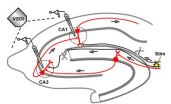(Press-News.org) For two decades, scientists have known the biochemical factors that trigger penile erection, but not what's needed to maintain one. Now an article by Johns Hopkins researchers, scheduled to be published this week by the Proceedings of the National Academy of Sciences (PNAS), uncovers the biochemical chain of events involved in that process. The information, they say, may lead to new therapies to help men who have erectile dysfunction.
"We've closed a gap in our knowledge," says Arthur Burnett, M.D., professor of urology at Johns Hopkins Medicine and the senior author of the study article. "We knew that the release of the chemical nitric oxide, a neurotransmitter that is produced in nerve tissue, triggers an erection by relaxing muscles that allow blood to fill the penis. We thought that was just the initial stimulus. In our research, we wanted to understand what happens next to enable that erection to be maintained."
In a study of mice, Burnett and his colleagues found a complex positive feedback loop in the penile nerves that triggers waves of nitric oxide to keep the penis erect. He says they now understand that the nerve impulses that originate from the brain and from physical stimulation are sustained by a cascade of chemicals that are generated during the erection following the initial release of nitric oxide. "The basic biology of erections at the rodent level is the same as in humans," he says.
The key finding is that after the initial release of nitric oxide, a biochemical process called phosphorylation takes place to continue its release and sustain the erection.
In a landmark study published in the journal Science in 1992, Burnett and his Johns Hopkins co-author, Solomon S. Snyder, M.D., professor of neuroscience (who is also an author on the current study), showed for the first time that nitric oxide is produced in penile tissue. Their study demonstrated the key role of nitric oxide as a neurotransmitter responsible for triggering erections.
"Now, 20 years later, we know that nitric oxide is not just a blip here or there, but instead it initiates a cyclic system that continues to produce waves of the neurotransmitter from the penile nerves," says Burnett.
With this basic biological information, it may be possible, according to Burnett, to develop new medical approaches to help men with erection problems caused by such factors as diabetes, vascular disease or nerve damage from surgical procedures. Such new approaches could be used to intervene earlier in the arousal process than current medicines approved to treat erectile dysfunction.
In particular, Burnett says, "The target for new therapies would be the protein kinase A (PKA) phosphorylation of neuronal nitric oxide synthase (nNOS). Now that we know the mechanism for causing the 'activated' form of nNOS in penile nerves, we can develop agents that exploit this mechanism to help with erection difficulties."
One of the agents studied by the researchers was forskolin, an herbal compound that has been used to relax muscle and widen heart vessels. They found that forskolin also ramps up nerves and can help keep nitric oxide flowing to maintain an erection.
"It has been a 20-year journey to complete our understanding of this process," says Snyder. "Now it may be possible to develop therapies to enhance or facilitate the process."
###The new study, "Cyclic AMP Dependent Phosphorylation of Neuronal Nitric Oxide Synthase Mediates Penile Erection," was funded by the National Institute of Diabetes and Digestive and Kidney Diseases (NIDDK), under grant number RO1DK067223.
In addition to Burnett and Snyder, the study article's authors are K. Joseph Hurt from the University of Colorado, Sena F. Sezen, Gwen F. Lagoda and Biljana Musicki from Johns Hopkins, and Gerald A. Rameau from Morgan State University.
Researchers uncover biochemical events needed to maintain erection
Discovery in mice may lead to new therapies for erectile dysfunction in men
2012-09-26
ELSE PRESS RELEASES FROM THIS DATE:
Moffitt Cancer Center researchers say smoking relapse prevention a healthy step for mothers, babies
2012-09-26
Researchers at Moffitt Cancer Center, concerned that women who quit smoking during their pregnancies often resume smoking after they deliver their baby, tested self-help interventions designed to prevent postpartum smoking relapse.
"We'd first like to see more women quit smoking when they become pregnant," said Thomas H. Brandon, Ph.D., senior member at Moffitt and chair of the Department of Health Outcomes and Behavior. "However, even among those who do quit, the majority return to smoking shortly after they give birth."
According to the researchers, nearly 50 percent ...
Severe hunger increases breast cancer risk in war survivors
2012-09-26
Jewish women who were severely exposed to hunger during World War Two were five times more likely to develop breast cancer than women who were mildly exposed, according to research in the October issue of IJCP, the International Journal of Clinical Practice.
The study also found that women who were up to seven-years-old during that period had a three times higher risk of developing breast cancer than women who were aged 14 years or over.
Sixty-five women diagnosed with breast cancer between 2005 and 2010 were compared with 200 controls without breast cancer. All ...
Slave rebellion is widespread in ants
2012-09-26
Ants that are held as slaves in nests of other ant species damage their oppressors through acts of sabotage. Ant researcher Professor Dr. Susanne Foitzik of Johannes Gutenberg University Mainz (JGU) in Germany first observed this "slave rebellion" phenomenon in 2009. According to the latest findings, however, this behavior now appears to be a widespread characteristic that is not limited to isolated occurrences. In fact, in three different populations in the U.S. states of West Virginia, New York, and Ohio, enslaved Temnothorax longispinosus workers have been observed to ...
Learning requires rhythmical activity of neurons
2012-09-26
This press release is available in German.
The hippocampus represents an important brain structure for learning. Scientists at the Max Planck Institute of Psychiatry in Munich discovered how it filters electrical neuronal signals through an input and output control, thus regulating learning and memory processes. Accordingly, effective signal transmission needs so-called theta-frequency impulses of the cerebral cortex. With a frequency of three to eight hertz, these impulses generate waves of electrical activity that propagate through the hippocampus. Impulses of a different ...
New AACP Practice Parameter on gay, lesbian, bisexual, and gender variant issues
2012-09-26
Washington D.C., September 26, 2012 – The American Academy of Child and Adolescent Psychiatry (AACAP) is proud to announce its new Practice Parameter on issues related to and affecting gay, lesbian, bisexual, and gender variant youth.
Gay, lesbian, bisexual, and gender variant children and adolescents face unique developmental challenges and stressors that can influence their mental health and wellbeing. Social issues such as stigma, bullying, and discrimination, and personal factors like internalized prejudice and feelings of being different are just a few of the concerns ...
Melatonin and exercise work against Alzheimer's in mice
2012-09-26
The combination of two neuroprotective therapies, voluntary physical exercise, and the daily intake of melatonin has been shown to have a synergistic effect against brain deterioration in rodents with three different mutations of Alzheimer's disease.
A study carried out by a group of researchers from the Barcelona Biomedical Research Institute (IIBB), in collaboration with the University of Granada and the Autonomous University of Barcelona, shows the combined effect of neuroprotective therapies against Alzheimer's in mice.
Daily voluntary exercise and daily intake ...
New simulation method produces realistic fluid movements
2012-09-26
What does a yoghurt look like over time? The food industry will soon be able to answer this question using a new fluid simulation tool developed by the Department of Computer Science (DIKU) at the University of Copenhagen as part of a broad partnership with other research institutions. An epoch-making shift in the way we simulate the physical world is now a reality.
A five-year collaboration between the University of Copenhagen, the Technical University of Denmark (DTU) and the Alexandra Institute on simulating fluids in movement is now bearing fruit, and has earned the ...
How is a Kindle like a cuttlefish
2012-09-26
Over millions of years, biological organisms – from the chameleon and cuttlefish to the octopus and squid – have developed color-changing abilities for adaptive concealment (e.g., camouflage) and communication signaling (e.g., warning or mating cues).
Over the past two decades, humans have begun to develop sophisticated e-Paper technology in electronic devices that reflect and draw upon the ambient light around you to create multiple colors, contrast and diffusion to communicate text and images.
And given the more than 100 million years head start that evolution has ...
Reducing acrylamide levels in french fries
2012-09-26
The process for preparing frozen, par-fried potato strips — distributed to some food outlets for making french fries — can influence the formation of acrylamide in the fries that people eat, a new study has found. Published in ACS' Journal of Agricultural and Food Chemistry, the study identifies potential ways of reducing levels of acrylamide, which the National Toxicology Program and the International Agency for Research on Cancer regard as a "probable human carcinogen."
Acrylamide forms naturally during the cooking of many food products. Donald S. Mottram and colleagues ...
Preserving large females could prevent overfishing of Atlantic cod
2012-09-26
Cod are among Sweden's most common and most popular edible fish and have been fished hard for many years. One consequence is the risk of serious changes in cod stocks, reveals research from the University of Gothenburg, Sweden.
In overfished areas, there is often a shortage of large and old cod, and the fish become sexually mature at a younger age. Researchers have feared that this change may have impacted on the fish's health, physiological ageing and reproductive capacity.
In a recently published study, a research group from the University of Gothenburg working with ...
LAST 30 PRESS RELEASES:
Manta rays create mobile ecosystems, study finds
Study: Mixed results in using lipoic acid to treat progressive multiple sclerosis
Norbert Holtkamp appointed director of Fermi National Accelerator Laboratory
New agentic AI platform accelerates advanced optics design
Biologists discover neurons use physical signals — not electricity — to stabilize communication
Researchers discover that a hormone can access the brain by hitchhiking
University of Oklahoma researcher awarded funding to pursue AI-powered material design
Exploring how the visual system recovers following injury
Support for parents with infants at pediatric check-ups leads to better reading and math skills in elementary school
Kids’ behavioral health is a growing share of family health costs
Day & night: Cancer disrupts the brain’s natural rhythm
COVID-19 vaccination significantly reduces risk to pregnant women and baby
The role of vaccination in maternal and perinatal outcomes associated with COVID-19 in pregnancy
Mayo Clinic smartwatch system helps parents shorten and defuse children's severe tantrums early
Behavioral health spending spikes to 40% of all children’s health expenditures, nearly doubling in a decade
Digital cognitive behavioral treatment for generalized anxiety disorder
Expenditures for pediatric behavioral health care over time and estimated family financial burden
Air conditioning in nursing homes and mortality during extreme heat
The Alps to lose a record number of glaciers in the next decade
What makes a good proton conductor?
New science reporting guide published for journalists in Bulgaria
New international study reveals major survival gaps among children with cancer
New science reporting guide published for journalists in Turkey
Scientists develop a smarter mRNA therapy that knows which cells to target
Neuroanatomy-informed brain–machine hybrid intelligence for robust acoustic target detection
Eight SwRI hydrogen projects funded by ENERGYWERX
The Lundquist Institute and its start-up company Vitalex Biosciences Announces Strategic Advancement of Second-Generation fungal Vaccine VXV-01 through Phase 1 Trials under $40 Million Competitive Con
Fine particles in pollution are associated with early signs of autoimmune disease
Review article | Towards a Global Ground-Based Earth Observatory (GGBEO): Leveraging existing systems and networks
Penn and UMich create world’s smallest programmable, autonomous robots
[Press-News.org] Researchers uncover biochemical events needed to maintain erectionDiscovery in mice may lead to new therapies for erectile dysfunction in men


